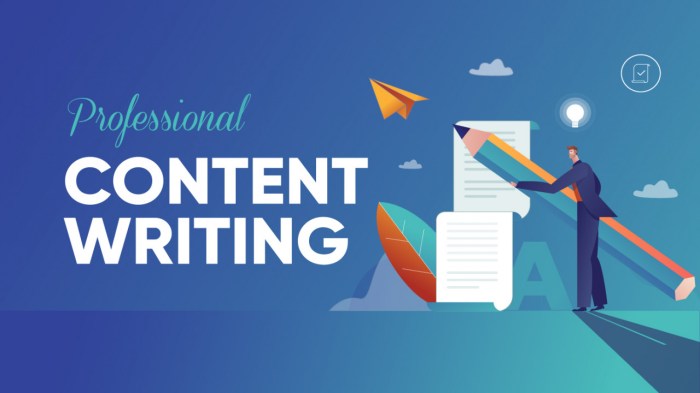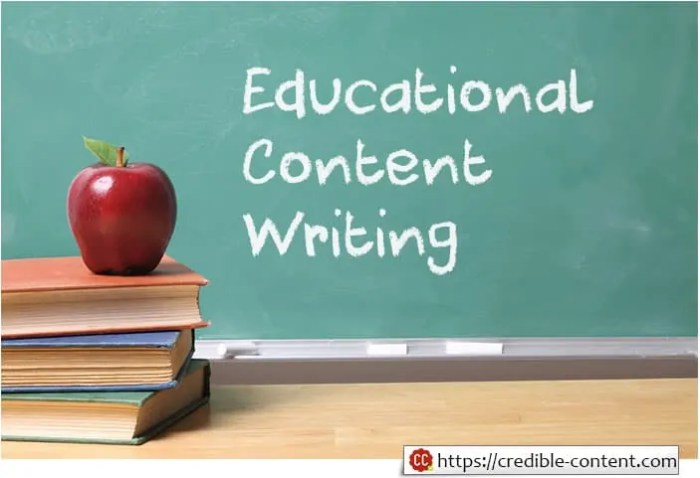Writing Educational Content takes center stage, inviting readers into a world of knowledge that ensures an absorbing and original experience. From the importance of clarity to strategies for engagement, this topic covers it all.
Importance of Educational Content: Writing Educational Content
Educational content plays a crucial role in the learning process by providing students with valuable information, knowledge, and skills that are essential for their academic development.
Enhancing Understanding
Well-written educational content has the power to enhance understanding by breaking down complex concepts into simpler terms, providing real-world examples, and offering practical applications.
- Engaging visuals and diagrams can help students visualize abstract ideas, making them easier to grasp and remember.
- Interactive activities and hands-on experiments can reinforce learning and deepen understanding through practical experience.
- Clear explanations and step-by-step instructions can guide students through challenging topics, helping them overcome obstacles and build confidence.
Impact on Student Retention and Comprehension
Engaging educational material has a significant impact on student retention and comprehension, as it keeps learners actively involved and motivated to explore new ideas and concepts.
- Regular exposure to well-structured educational content can help reinforce learning and improve memory retention over time.
- Interactive quizzes and assessments can test students’ understanding of the material and identify areas that require further review or clarification.
- Collaborative projects and group discussions can encourage students to apply their knowledge in real-world scenarios, fostering critical thinking and problem-solving skills.
Characteristics of Effective Educational Content

Effective educational content is characterized by several key elements that make it engaging and informative for learners of all ages. Clarity, organization, and the use of visuals play a crucial role in enhancing educational materials, making them more accessible and impactful.
Clarity and Organization
Clarity and organization are essential components of effective educational content. Clear and concise explanations help students grasp complex concepts more easily, while a well-organized structure ensures that information is presented in a logical and coherent manner. When educational materials are easy to follow and understand, learners are more likely to retain the information and apply it in real-world situations.
- Clear explanations using simple language and examples
- Logical flow of information from basic concepts to advanced topics
- Consistent formatting and structure to aid comprehension
- Effective use of headings, subheadings, and bullet points to highlight key points
Role of Visuals
Visual aids, such as diagrams, charts, and illustrations, play a significant role in enhancing educational content. Visuals help to break down complex information into digestible chunks, making it easier for students to understand and remember key concepts. By incorporating visuals into educational materials, educators can cater to different learning styles and enhance the overall learning experience.
- Diagrams and charts to visualize relationships and processes
- Illustrations to bring abstract concepts to life
- Infographics to summarize information in a visually appealing way
- Use of color, shapes, and symbols to aid retention and recall
Strategies for Creating Engaging Educational Content

To create educational content that captivates students’ attention, it’s important to employ strategies that make learning interactive and relatable. By incorporating elements like quizzes, exercises, and storytelling techniques, educators can enhance the overall learning experience and increase student engagement.
Incorporating Interactive Elements
Utilize interactive elements such as quizzes and exercises to break up the content and reinforce key concepts. These activities provide students with opportunities to apply their knowledge in a practical way, making the learning process more engaging and memorable.
- Include interactive quizzes at the end of each section to test students’ understanding and retention of the material.
- Integrate hands-on exercises that allow students to practice new skills or concepts in a real-world context.
- Utilize multimedia elements like videos, animations, or simulations to enhance the learning experience and cater to different learning styles.
Utilizing Storytelling Techniques, Writing Educational Content
Storytelling is a powerful tool for making educational content more relatable and engaging. By weaving narratives into the material, educators can create a sense of connection and emotional resonance that helps students retain information more effectively.
- Introduce relatable characters or scenarios that students can identify with to make the content more engaging and memorable.
- Use storytelling to illustrate complex concepts or processes in a way that is easy to understand and remember.
- Incorporate cliffhangers or plot twists to keep students invested in the content and eager to learn more.
Adapting Educational Content for Different Learning Styles
Tailoring educational content to suit visual, auditory, and kinesthetic learners is crucial for ensuring that all students can engage with and understand the material effectively. By incorporating various formats and strategies, educators can create a more inclusive learning environment that caters to diverse learning preferences.
Visual Learners
- Provide visual aids such as diagrams, charts, and graphs to help illustrate key concepts.
- Use color coding and highlighting to emphasize important information.
- Incorporate videos and animations to bring complex topics to life.
Auditory Learners
- Include podcasts or audio recordings of lectures for students who prefer listening to information.
- Encourage group discussions and verbal explanations to reinforce learning through dialogue.
- Use mnemonic devices and catchy tunes to help students remember key facts and concepts.
Kinesthetic Learners
- Organize hands-on activities and experiments to allow students to learn through physical experiences.
- Incorporate movement into lessons, such as role-playing exercises or interactive simulations.
- Encourage tactile learning by using manipulatives and real-world objects to demonstrate abstract concepts.
By offering diverse formats such as videos, text, and audio, educators can accommodate different learning styles and preferences, ensuring that all students have the opportunity to engage with the material in a way that resonates with them. Adapting educational content to suit visual, auditory, and kinesthetic learners not only enhances understanding and retention but also promotes a more inclusive and equitable learning environment for all students.
